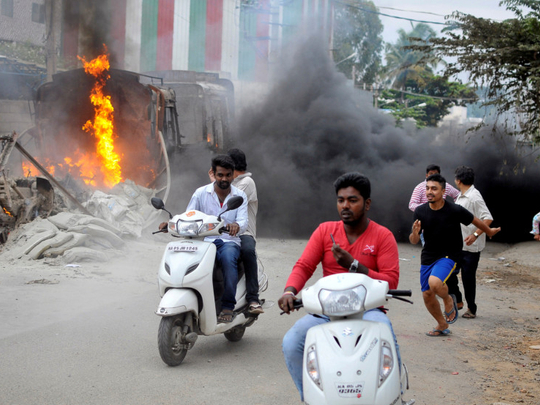
Be it Kashmir or Karnataka, poor governance in India has been responsible for making a bad situation worse. Administrative lapses are true of minor incidents of lawlessness as well, like the antics of the “gau rakshaks” or the cow vigilantes, who have been running amok from Mewat in Haryana to Bengaluru in Karnataka. Similarly, the inept rulers have let down Delhi at a time of dengue and chikungunya outbreaks.
But when the gross inadequacies of a ruling party lead to a major disturbance like the one in Bengaluru, a widespread sense of insecurity assails tourists, investors and ordinary people. The failure of Karnataka’s Congress government was its inability to assess the threat posed by local anger over the release of the waters of Cauvery River for Tamil Nadu at the expense of the state’s farming and drinking water requirements. This inexplicable lapse led to the burning of 40-odd luxury buses with Tamil Nadu number plates at a Bengaluru bus depot.
While the cosmopolitan city, which is India’s pride as an information technology centre, was at the mercy of rampaging mobs for several hours, the police were nowhere to be seen till curfew was imposed as late as 10.30pm (local time)/
Yet, if the authorities had been alert to the growing tension, especially after an eatery run by a Kannadiga was attacked in Chennai, much of the mayhem could have been avoided and Bengaluru’s reputation partly saved. All that was needed was to increase the number of police patrolling parties and of stationary pickets before the arson took place and not afterwards. There is nothing so effective as a show of force to deter the volatile underclass of lumpen elements who are present in nearly all Indian towns, big and small, and who take to the streets at the slightest provocation. The targeting of Africans and of people from India’s Northeastern states in Bengaluru not long ago were the handiwork of these unruly groups. But the government of Chief Minister Siddaramaiah did not take cognizance of their potential for mischief till the city was shamed by the television pictures of burning buses.
Cynics have suggested that it looked the other way for several hours so as not to antagonise the Kannadiga activists. No government — past or present — paid any attention to a riverine problem that has been simmering for a century. In the case of both Karnataka and Tamil Nadu, the root of the problem lies in the cultivation of water-guzzling crops like rice and sugarcane, for which the waters of the Cauvery are no longer adequate, especially in a year of scarce rainfall. The Cauvery has also been “dying” because of the pollution caused by the inflow into it of untreated industrial effluents and of sewage.
Much of the problem could have been solved if, first, the causes of pollution were eradicated and, more importantly, the farmers were persuaded to switch to growing millets, oilseeds, pulses and other crops that do not require much water. But such initiatives take time and dedication, neither of which is high on the priority list of politicians who are intent on merely winning the next election; or of bureaucrats preoccupied with advancing their career prospects rather than looking for permanent solutions.
It was the same in Kashmir, where no thought was given to ways of dealing with Burhan Wani — whether he should be killed or kept cooped up. He and his followers were subsequently smoked out by the security forces, before Wani was killed.
Had all the alternatives been discussed and decided on, the present unrest in the Kashmir Valley could have been avoided. But the Indian habit is apparently to avoid tactical and strategic measures. Instead, the preference is for responding to an evolving situation on a case-by-case basis or playing it by the ear, as the phrase goes.
Not surprisingly, the judiciary has become the last resort, with the governments washing their hands of difficult situations. However, the judiciary cannot assuage the public mood with its cut-and-dried formulas like telling the Karnataka government to release 15,000 cusecs of water per day for Tamil Nadu for 10 days, which was later modified to 12,000 cusecs though over a longer period of time.
Nor does its diktats outlawing agitations have any meaning in a democracy. As much is evident from the 12-hour general strike called in Tamil Nadu, a day after the judicial directive, to register the state’s protest against the ill-treatment of Tamils in Karnataka.
Whether it is stopping the cow vigilantes from assaulting suspected beef eaters or providing adequate health care to citizens during an outbreak of mosquito-borne diseases, governance is the key.
What this means is that Indian politicians have to be alive to their responsibilities and liaise with the officials to address a problem swiftly and determinedly before it gets out of hand. Yet, they are generally found to be remiss in the performance of these basic tasks.
— IANS
Amulya Ganguli is a political analyst.










